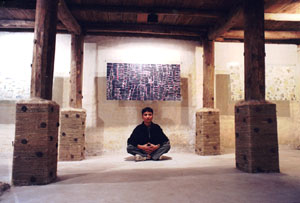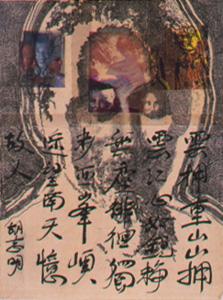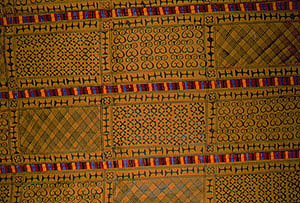








Exhibitions - Spring 2000
| January 31 - March 10 |
St. Lawrence University Festival of the Arts
|
February 25 |
Festival of the Arts |
| March 20 - April 21 |
The Spirit of West African Textiles |
| March 20 - June 4 |
InMidmomenT: lines.spaces.boundaries. Works by Ada Udechukwu |
June 4 | Barnes Endowment Annual Juried Student Art Exhibition |
Reconsidering Vietnam
St. Lawrence University Festival of the Arts
- January 31 - March 10, 2000
- Related Educational Programs

This year's Festival of the Arts focuses on the visual and performing arts and literature of contemporary Vietnam. Though the festival itself runs from February 21 through March 8, the exhibition begins beforehand on January 31 and includes an artist's residency from February 14 through 25. The work of four artists from Vietnam or the United States will be featured: An-My Lê, Tran Luong, C. David Thomas, and Hien Duc Tran. The exhibition curator writes:
- My goal in organizing this exhibition is to bring together four artists' work in order to challenge and expand the viewer's knowledge of Vietnam, the land and the people. Whether through experiencing Hanoi artist Tran Luong's thought-provoking installations that question cultural survival in his changing world. Or by looking at New York artist An-My Lê's quiet and sensitive photographs of her motherland which present a view rarely seen by Americans. Or in looking at and reading Boston artist Hien Duc Tran's moving portraits and interviews of Amerasian children that depict an often overlooked legacy of the war in Vietnam. And through my portraits and book about Ho Chi Minh, I ask the viewer to reexamine, or in most cases examine for the first time, this complex figure who led his country against the French and the Americans.
C. David Thomas
Professor of Studio Art, Emmanuel College
Director, Indochina Arts Partnership

gelatin silver print, 16 x 22 x 1/2 inches
An-My Lê
My brothers and I walked out of our home in 1975, each carrying a rucksack with a shirt, a pair of pants, and a toothbrush. Onto the C-130, to the Philippines navy base, to Wake Island, to Guam Island, another base, to Camp Pendleton near San Diego. We only had our rucksacks to carry. We only let go of the rucksacks when we entered civilian life in Southern California three months later.
We did let go of those few things we took out of Vietnam, but ever since, we have begun to carry many other things with us: a certain memory of the place, of our life, a sense of lost history, of a disjuncted past. Over the years, as the exact details lost their sharpness, we reworked the thoughts, reshaped the images, the memories of smells, sounds, and touch.
These photographs are from the latest exploration of the ideas and perceptions of Vietnam I have been carrying around with me for so many years. It's as far as it can be from a document of present-day Vietnam. I really see these photographs as being about a fantasy I've been having about Vietnam, especially compounded because for the longest time we did not think we could ever return there. - AL

Tran Luong
Of the artist's work, Vietnamese art critic Phan Cam Thuong writes:
- Tran Luong paints with all the indistinct emotion raised by [certain things or events] or some occasional amorous suggestion inspired by the sensitiveness of figures and shapes. In his lotus pictures, he reveals a hidden melancholy, and his paintings communicate a prolonged and agonized reflection, at times accentuated, at times [more subtle]. These lingering feelings give his artwork a certain degree of profundity and sophistication. In his pictures, we read the unquietness of his inner feelings, the conflict between nascent thoughts that cannot find any suitable form of expression….

mixed media on paper, 28 x 20 inches
C. David Thomas
I returned to Vietnam with the U.S. Indochina Reconciliation Project in 1987 for the first time since the War. During that three-week trip, I began to question everything I knew about Vietnam. I found the people friendly and welcoming, while at the same time suffering in large part due to the long-standing trade embargo placed against them by a succession of U.S. presidents. During this trip, I also began to read about Bac (Uncle) Ho, as the Vietnamese call him, the man whose picture was omnipresent in Vietnam.
Since then, I have searched through bookstores and libraries in Vietnam and the United States to locate information on Ho Chi Minh. Two modest books gave me a more complete picture of this complex man—David Halberstam's 118-page Ho, published in 1971, and Charles Fenn's 144-page biography entitled Ho Chi Minh, published in 1973. Over the years, I have added several other books, but it still amazes me how little information is available more than 30 years after his death. Can anyone deny the importance of the man who changed the course of world history?
That is why I began this project two years ago. It is my attempt as an artist to provide a sketch of Ho's complex life. I hope to humanize a man who has long been deified and demonized. -CDT

1989, chromogenic color print, 9 x 13 inches
Hien Duc Tran
Of course, many people helped me clarify my thoughts about the photographs I show here—words, grammar, scent, and sense. But most of all it has been the Amerasians themselves to whom my heart has listened; I am in deep gratitude to them all. Yet, even so, I cannot quite escape the feeling that I have somehow sinned against them, a kind of simony of their suffering. For this charge—that accusation of the boy I quote further on in this exhibition—I have no real defense beyond that ancient justification that spiritual beauty must always be recorded. In the suffering of these children, I have felt a terrible beauty breaking forth for which I must personally make a record.
These then are their faces; these are the circumstances under which some of these photographs were made, some of my thoughts, some of their words. I feel honored they invested so much with me. And while they more easily permitted my questions and prying lens in Vietnam than they ever could in New England, it is here that I have come to understand and appreciate the bravery of these children who have survived so much, now, finally, surviving even their dreams themselves.-HDT
The Spirit of West African Textiles
- March 20 – April 21, 2000
- Related Educational Programs

"…beneath the skin, beyond the differing features, and into the true heart of being, fundamentally, we are more alike, my friend, than we are unalike."
-Maya Angelou
The Spirit of West African Textilesexplores a variety of cultural and spiritual motifs steeped in tradition and woven with joyful self-expression. In my experience, the wisdom of Africa can speak to contemporary American society at a time when many may feel a need to connect to a spiritual source, to belong to a community, and to reclaim a rightful relationship with one's ancestors. Accordingly, the presentation of these objects speaks to a desire to embrace the teachings of West African cultures.
The exhibition includes more than sixty textile-based objects from the private collection of Roda and Gilbert Graham. Examples of both woven and non-woven cloth, raffia palm velvet cloth, and brilliantly hued Kente cloth pulsate with the vitality of the connection between the wearer of the garment, the surrounding community, and the ancestors. The ritual of making textiles for personal adornment is represented in objects from Nigeria, Cameroon, Côte d'Ivoire, Zaire, Mali, and Ghana, among others.
In an effort to share certain West African traditions with area students and community members in rural northern New York, we have developed a series of hands-on creative workshops on dance and percussion, personal power symbols, and self-adornment. At a time when the veils are thin, this exhibition invites us to wrap ourselves in the spirit of West Africa.
-Lorien R. Eck
Educational Programs
The Spirit of West African Textiles is organized and circulated by the Council for Creative Projects, Lee, MA, and New York, NY.
InMidmomenT: lines. spaces. boundaries.
Works by Ada Udechukwu
- March 20 – June 4, 2000
- Related Educational Programs

Ada Udechukwu, InMidmomenT, 1999,
artist's book, charcoal and ink on paper
Recent works on paper, including drawings, artist's books, and a selection of poetry by Ada Udechukwu will be presented in the hallway gallery. This exhibition and The Spirit of West African Textiles are presented in concert with African Arts Into the Next Millenium, a series of lectures and readings by internationally-acclaimed African writers. Udechukwu writes:
…it is in the dialogue between my poetry, drawings, and paintings, that "threads gather to intricate fabric." At the core of my creative work in these spheres lies the elemental bond they share, a bond that is located in my "conversations with self." As a result, they exist on several shared levels. I started writing, and later drawing and painting, in response to a personal need to work out my emotions and the experiences from which they arise. In essence, my art provides a forum for coming to terms with life and putting it into perspective. My art, literary and visual, is essentially a means of giving voice to the silences in my life, to those intimate areas that shape me as an individual. Closely linked with this is the exploration of "touch" in human interaction. There is, within this context, a preoccupation with giving form to the fluidity of contact, separation, distance, …love, and the emotional undercurrents that arise therefrom. In navigating these ebbs and flows, I continually challenge myself to explore emotional experience as I search for that which lingers after the words, after the images.
At the center of my thematic concerns is the duality inherent in human nature and the intangible emotional currents it produces in the course of human interaction. I am concerned with communicating the force of emotion in human life, its undercurrents, and the often imperceptible threads it weaves around our lives. On an aesthetic level, one of the major influences in my art has been a growing knowledge of uli. The dominant characteristics of uli – abstraction, linearity, and balance between positive shape and negative space – are at the core of communicating experience in my poetry and visual art where economy of word and economy of line work to create the unspoken, the open spaces that speak in my work.
Ada Udechukwu
from Twin tributaries: my poetry, my art
Canton, NY 1998
InMidmomenT
fall songlines begin
unfolding, refolding… in
leaf-lines and midribs
Autumn, 1999
winds speak in silence
filtering dust-held patterns
inwoven gold-thread
Harmattan, 1967
Nsukka awash
bloodlines holding earth and sky
etching beaten paths
Rains, 1997
Born in 1960 in Enugu, Nigeria, Ada Udechukwu holds a B.A. in English and African literature from the University of Nigeria, Nsukka. She has published a book of poems, Woman, Me (Bayreuth: Boomerang Press, 1993), and Herero (NY: The Rosen Publishing Group, 1996). In 1997-98, a selection of her drawings was exhibited in The Poetics of Line: Seven Artists of the Nsukka Group at the National Museum of African Art in Washington, D.C. She has also shown her work at the University of Nigeria, Nsukka, and the Goethe Institut, Lagos, Nigeria.
Annual Juried Student Art Exhibition
The Annual Barnes Endowment Exhibition
- May 2 - June 4, 2000
- Related Educational Programs

Sarah Lott '00, Seasonal Cowgirl, 2000, gelatin silver print
Student artwork in all media, including drawing, painting, photography, sculpture, ceramics, and printmaking, will be presented in this exhibition organized by the Student Art Union and the Department of Fine Arts. The Annual Juried Student Art Exhibition, open to all St. Lawrence University students, is the annual Barnes Endowment Exhibition, with additional funding provided by the Jeanne Scribner Cashin Endowment for Fine Arts.
All exhibitions and related educational programs are free and open to the public. The Gallery welcomes individuals and groups for guided tours; please call (315) 229-5174 for information.
| Gallery hours | |
| Monday-Thursday Friday and Saturday |
12-8 p.m. 12-5 p.m. |
top of page